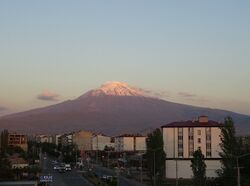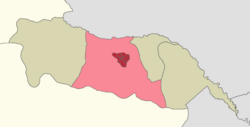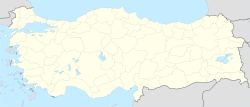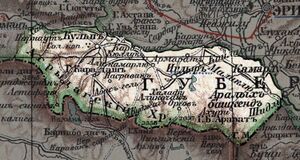إغدير
إغدير
Iğdır | |
|---|---|
 Mount Ararat from Iğdır | |
 | |
| الإحداثيات: 39°55′N 44°02′E / 39.917°N 44.033°E | |
| البلد | |
| المنطقة | الأناضول الشرقية |
| المحافظة | إغدير |
| District | Iğdır Central District |
| الحكومة | |
| • الوالي | Nurettin Aras |
| • Elected Mayor | Yaşar Akkuş (HDP) (deposed) |
| • Acting Mayor (Governor of Iğdır Province) | Hüseyin Engin Sarıibrahim (State-appointed trustee) |
| المساحة | |
| • بلدية | 1٬479 كم² (571 ميل²) |
| • District | 1٬431٫17 كم² (552٫58 ميل²) |
| المنسوب | 850 m (2٬790 ft) |
| التعداد (2009)TÜİK | |
| • Urban | 76٬950 |
| • District | 128٬976 |
| • كثافة District | 90/km2 (230/sq mi) |
| Postal code | 76000 |
| مفتاح الهاتف | 0476 |
| Licence plate | 76 XX XXX |
| الموقع الإلكتروني | Iğdır Municipality |
مدينة إغدير (بالتركية: Iğdır ؛ بالأرمينية: Իգդիր, formerly Ծոլակերտ, Tsolakert) هي عاصمة محافظة إغدير في أقصى شرق تركيا ويبلغ تعداد سكانها حوالي 59,880 نسمة تقع بالقرب من أرمنيا وأذربيجان وإيران. الحدود مع أرمنيا يشكلها نهر أراس. وأعلى جبال تركيا أغري داغي (جبل أرارات) يقع في هذه المحافظة، إلا أن معظم أراضيها سهول منبسطة.
التاريخ
Iğdır went by the Armenian name of Tsolakert during the Middle Ages.[2] When the Spanish traveler Ruy González de Clavijo passed through this region in the early 15th century, he stayed a night in a castle he called Egida, located at the foot of Mount Ararat. Clavijo describes it as being built upon a rock and ruled by a woman, the widow of a brigand that Timur had put to death.[3] Because modern Iğdır has no such rock, and is a considerable distance from the Ararat foothills, it is believed that medieval Iğdır was located at a different site, at a place also known as Tsolakert, now called Taşburun. Russian excavations there at the end of the 19th century discovered the ruins of houses and what was identified as a church, as well as traces of fortifications. The settlement may have been abandoned after an earthquake in 1664.[4] In 1555 the town became a part of the Safavid Empire, remaining under Persian rule (with brief military occupations by the Ottomans in 1514, between 1534–35, 1548–49, 1554–55, 1578–1605, 1635–36 and 1722–46) until it fell into the hands of the Russian Empire after the Russo-Persian War of 1826-1828.[2]
التاريخ الحديث
Iğdır, or Igdir, was taken by the Russian Empire from Persia after the latter's defeat in the Russo-Persian War of 1826-1828. It was organized as part of the Armenian Oblast in 1828 and made a part of the Georgia-Imeretia Governorate in 1840, and then the Surmalu Uyezd of the Erivan Governorate in 1850. According to the Russian family lists accounts from 1886, of the total 30,647 inhabitants of the district 11,868 were Tatars (38.7%, later known as Azerbaijanis), 15,204 Armenians (49.6%) and 3,575 Kurds (11.7%).[5] An 1894 publication counted 2,912 Armenians living in the town.[6] Under Russian rule, two primary schools, one for boys and the other for girls, and three churches were opened and 100 Armenian families were allowed to move to Igdir. The town's population rose to 10,000 in 1914 and largely busied itself with agriculture and commerce.[2]
Following the Russian Revolution of October 1917, the area came under the control of a temporary administrative committee created by the three main ethnic groups in the Caucasus. Though it attempted to negotiate a truce with the Ottoman Empire, Ottoman forces launched an eastward offensive and took Igdir on May 20, 1918. They occupied it until the signing of the Armistice of Mudros in November 1918. The Republic of Armenia then assumed control over Igdir. The Armenian population suffered heavily during the grueling winter of 1918–19, as famine, disease and the cold killed many.[7][8] In May 1919, its status was elevated to that of a city.[9]
Based on the boundaries drawn by US State Department in November 1920, Igdir was envisaged to become a part of the Republic of Armenia. However, in September 1920 the government of the Grand National Assembly of Turkey led by Mustafa Kemal launched a war to eliminate the republic and overran Igdir.[10] Turkish General Kâzım Karabekir commanded the armies but his forces were initially unable to take Igdir due to strong Armenian resistance.[11] However, within a few days, on October 20, 1920, the Turkish Army managed to drive the Armenian forces out of the city and went on to capture Gyumri.[12] According to official Turkish documents, after their defeat in the Shahtahti area, Armenian forces abandoned Iğdır. They burned the Markara Bridge which spanned the Aras river and retreated to the northern bank on November 13, 1920. Turkey annexed the region of Iğdır after the conclusion of several peace treaties, and its territorial gains were mainly formalized under the 1921 Treaty of Kars.
In the early years of the Republic of Turkey, Igdir, now Iğdır, was a district of the province of Bayazıt. It was made a part of the Kars Province in 1934 and remained part of it until it became the seat of the newly formed Iğdır Province on 27 May 1992.[13]
الحكم
In the municipal elections of March 2019, Yaşar Akkuş from the Peoples' Democratic Party (HDP) was elected mayor.[14] He was dismissed due to terror related investigations on 15 May 2020,[15] and Enver Ünlü, the Governor of the province,[16] was appointed as a trustee for the municipality on the same day.[15]
الجغرافيا
The city of Iğdır sits on a plain at a lower altitude than most of Turkey's eastern provinces. This allows agricultural production including apples, tomatoes, cucumbers, peaches, pears, sugar beet, watermelons and melons. However, the most famous produce of Iğdır are cotton and apricots.
نصب التطهير العرقي
في أغسطس 1997، بدأ إنشاء "Iğdır Soykırım Anıt-Müzesi" ("نصب ومتحف مذبحة إغدير"). وقد أقامت السلطات التركية النصب لتخليد ذكرى المذابح المزعومة للأتراك التي قام بها الأرمن أثناء فترة الحرب العالمية الأولى. ويـُرى إنشاؤه كجزء من إنكار التطهير العرقي للأرمن المتواصل من جانب تركيا.[17] المؤرخة تسا هوفمان كتبت "على حدود أرمنيا، بالقرب من إغدير، يسمو نصب عسكري ارتفاعه 45 متر، مكرَّس للطحايا الأتراك للتطهير العرقي على يد الأرمن. وقد بني في 5 أكتوبر 1999، ومعه متحف مماثل."[18]
الديمغرافيا
| Iğdır Centrum Population | |||
|---|---|---|---|
| 2007 | 75.927 | ||
| 2000 | 59.880 | ||
| 1997 | 44.334 | ||
| 1990 | 35.858 | ||
| 1985 | 29.460 | ||
| 1980 | 24.352 | ||
| 1975 | 29.542 | ||
| 1970 | 21.420 | ||
المناخ
تتميز إغدير بمناخ قاري معتدل. الطقس هو الأدفأ في هذا الجزء من تركيا.
| Ortalama Veriler | |||||||||||||
|---|---|---|---|---|---|---|---|---|---|---|---|---|---|
| الشهور | Jan | Feb | Mar | Apr | May | Jun | Jul | Aug | Sep | Oct | Nov | Dec | |
| Average high °C | 2.6 | 5.6 | 12.8 | 20.1 | 24.3 | 29.4 | 33.7 | 34.4 | 29.1 | 21.2 | 12.6 | 4.9 | |
| Average low °C | -7.3 | -4.9 | 0.1 | 6.5 | 10.5 | 14.3 | 18.3 | 17.7 | 12.2 | 6.1 | 0.2 | -4.2 | |
| مت. الأيام المشمسة | 2.7 | 4.1 | 5.4 | 6.1 | 7.5 | 9.6 | 10.1 | 9.9 | 8.5 | 6.3 | 4.3 | 2.4 | |
| مت. الأيام المطيرة | 5.8 | 6.5 | 7.6 | 11.2 | 15.0 | 10.6 | 5.5 | 4.1 | 4.0 | 8.3 | 6.9 | 6.2 | |
| kaynak: www.meteor.gov.tr | |||||||||||||
المدن الشقيقة
إغدير متوأمة مع:
الهامش
- ^ "Area of regions (including lakes), km²". Regional Statistics Database. Turkish Statistical Institute. 2002. Retrieved 2013-03-05.
- ^ أ ب ت (in أرمنية) s.v. "Igdir," Armenian Soviet Encyclopedia, 1978, vol. 4, p. 309.
- ^ Ruy González de Clavijo. The Broadway Travellers: Embassy to Tamerlane: 1403-1406. Trans. Guy le Strange. London: Routledge, 2004, p. 76.
- ^ Sinclair, Thomas A. Eastern Turkey: An Architectural and Archaeological Survey, vol. 1. London: Pindar Press, 1987, pp. 406-409.
- ^ (in روسية) Свод статистических данных о населении Закавказского края, ИГДЫРСКИЙ УЧАСТОК (1886 г.). Tiflis, 1893.
- ^ "ЭСБЕ/Игдырь — Викитека". ru.wikisource.org. Retrieved 2020-04-27.
- ^ Hovannisian, Richard G. (1971). The Republic of Armenia: Vol. 1: The First Year, 1918-1919. Berkeley: University of California Press. pp. 128–129. ISBN 0-520-01984-9.
- ^ Chater, Melville. "The Land Of The Stalking Death: a Journey Through Starving Armenia on an American Relief Train." National Geographic 36 (November 1919). Retrieved July 24, 2009.
- ^ Hovannisian. Republic of Armenia, p. 449, note 3.
- ^ Hovannisian, Richard G. (1996). The Republic of Armenia: Vol. 4: Between Crescent and Sickle, Partition and Sovietization. Berkeley: University of California Press. pp. 249–250, 284. ISBN 0-520-08804-2.
- ^ (in تركية) Genelkurmay Askerî Tarih ve Stratejik Etüt Başkanlığı Yayınları, Türk İstiklâl Harbi IIIncü Cilt: Doğu Cephesi (1919-1921). Ankara: Genelkurmay Basım Evi, 1995, p. 221.
- ^ British Documents on Foreign Affairs--Reports and Papers from the Foreign Office Confidential Print: From the First to the Second World War. The Soviet Union, 1917-1939, Volume 4, p. 388.
- ^ "Iğdır". İslam Ansiklopedisi. Vol. 19. Türk Diyanet Vakfı. 1999. pp. 81–82.
- ^ "Iğdır Seçim Sonuçları - 31 Mart 2019 Yerel Seçimleri". www.sabah.com.tr. Retrieved 2020-05-15.
- ^ أ ب admin (2020-05-15). "A trustee has been appointed to 6 municipalities with HDP!". News1 English (in الإنجليزية الأمريكية). Retrieved 2020-05-15.
- ^ "Enver Ünlü". www.igdir.gov.tr. Archived from the original on 2020-06-02. Retrieved 2020-05-15.
- ^ (بالألمانية) "The Perpetrators Memorialize Themselves: Turks Erect a Memorial for the Victims of Armenian attacks." Süddeutsche Zeitung, December 1, 1999, p. 10.
- ^ Dr. T. Hofmann, Armenians in Turkey
وصلات خارجية
- Official website of the Iğdır Municipality
- (لغة تركية) Official website of the Iğdır Province
- (لغة تركية) Iğdır's News website
- Articles with أرمنية-language sources (hy)
- Articles with روسية-language sources (ru)
- Articles with تركية-language sources (tr)
- CS1 الإنجليزية الأمريكية-language sources (en-us)
- Pages using gadget WikiMiniAtlas
- Short description is different from Wikidata
- Articles containing أرمنية-language text
- محافظة إغدير
- مدن تركيا
- منطقة شرق الأناضول
- Coordinates on Wikidata




